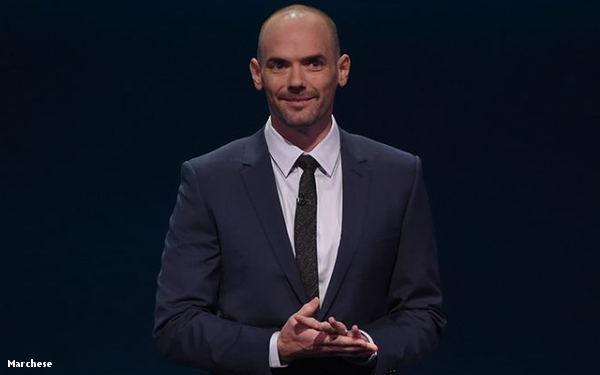Fox's Marchese: Can You Hear Me Now? -- Gets Upfront Attention With, Well, Attention
- by Joe Mandese @mp_joemandese, May 16, 2017

Just three days into his new job as president of advertising sales at Fox, Joe Marchese opened the network group’s upfront sales presentation in New York City Monday afternoon in a way that was bound to get every ad exec and media buyer’s attention.
"Consider this," Marchese told attendees, noting, "we as an industry have done studies to demonstrate that having the sound on is a more effective way of delivering your commercials."
“Seriously, let me repeat that…,” he added, at which point the audio on the loudspeaker system went mute and all you could hear was laughter from the audience.
Pause.
“…and that is the secret to the future of advertising. And tomorrow’s winning lottery numbers,” Marchese concluded as the audio came back on, sparking an ovation from the audience.
advertisement
advertisement
Sight -- and audio -- gags aside, Marchese’s main point is that Fox is not your father’s network group and this wan’t your old-school network upfront presentation, which ordinarily focus on prime-time star power.
The star of Marchese’s cold opening was human attention, and how Fox plans to deliver, measure and prove it going forward.
“Technology has given people infinite choices on how to spend their attention,” Marchese explained, adding: “But we as an industry get slowly left behind because we think about trading impressions, instead of attention. Even as the definition of attention drifts further and further from anything resembling attention.”
Marchese, who has championed attention- and time-based metrics throughout his career -- as founder of True[x] before selling it to Fox, and during his time as head of advanced advertising at the Fox networks group -- described how the advertising marketplace is approaching a “sub-prime crisis,” a theme he originally began articulating as a columnist on MediaPost’s Online Spin years ago.
“Advertising sub-prime is represented by non-viewable ads and unsavory content entering our ecosystem. All compounded by ad blockers, DVRs and growing ad-free options. These allow people to dictate their attention to us,” he continued, promoting Fox’s solutions:
1 - "Focusing on the metrics that matter."
2 - "Ad format innovation."
3 - "Advanced data applications."
4 - "Brand storytelling."
The biggest news of his speech was echoing a similar announcement made earlier in the day during NBC Universal’s upfront by head of sales Linda Yaccarino, who along with Fox’s Marchese, pledged to guarantee advertisers attention-based audience impressions utilizing Moat’s quality video data.
Importantly, Marchese said it wasn’t just using Moat for Fox’s digital audience impressions, but also has a plan to bring “it to linear measurement, as well.” He did not disclose how that would happen, but he said the new attention-based metrics, combined with Fox’s innovative attention-based ad formats, would enable advertisers to effectively hedge the subprime ad marketplace much in the same way that savvy hedge investors beat the housing market, as chronicled in Michael Lewis’ “The Big Short.”
“The common goal,” Marchese promised, would be “an improved viewer experience with outsized returns for you.”



So how does Moat know that digital "audiences" are "attentive"?
@Ed: Moat utilizes a variety of heuristics -- things like dwell time, time in-view, cursors moving on screens -- as a proxy for user attention. I don't know how they will apply that to linar TV, but it's a good follow up.
TAKE A THREE WEEK VACATION AND LEAVE THE TV ON FOR THE PET CAT. RIDDLE ME THAT ED.
WITH A NIELSEN PAPER DIARY AND TINY SAMPLE OF TV METERS OF COURSE
Joe, my problem with the kind of thing you describe and as explained on Moat's website is that it relies totally on electronic behaviour metrics like dwell time which while probably indicative are not very good surrogates for people-based studies of attentiveness such as those provided by eye cameras or ad recall studies. TVision has developed an eyes-on- screen system that seems far more promising in this regard.
Brilliant, LZ. You don't even know the difference between national and small market local TV ratings----something any trainee in an agency media department knows. Here's a short course for you about the upfront. First, it's for national broadcast network TV, syndication and cable buys not local. Second, Nielsen's peoplemeter ratings, not diaries of any kind are, the sole rating currency for upfront buys. The only time that diaries were employed for national TV buys was in the pre-peoplemeter days ( prior to 1987 ) but only as an audience composition source to refine electronic set usage ratings. Got it?
au contraire and ratings down 10-20% but still not giving up the ghost on audience....
Come on, LZ, let's think big. TV ratings are down by 50-75% and will be reduced to zero by next fall. Doesn't that fit in better with your wet dreams about the death of "linear TV"? Why bother with facts?
LZ - unattended viewing is edited out. Anyone who knows anything about media measurement knows that. At least TV edits it out - pity digital doesn't.
While Joe Marchesi gave the impression---a false one---that he was talking about TV in general, he was really referring to whatever digital "imprssions" fox sells to advertisers, not the linear ones which constitute over 95% of most buys in terms of audience tonnage. The metrics he mentions do not exist in "linear TV" nor will they for a long time---if ever. Also, moving cursors about and "dwell time", while directionally indicative as to the possibility of effective ad exposure, are very poor surrogates for making comparisons across various digital venues or platforms---like PCs vs mobile, for example--- and extremely questionable----though still indicative----when comparing digital "exposures" to linear TV's "commercial minute viewers".
Sorry Joe Marchese about misspelling your name in my last comment.